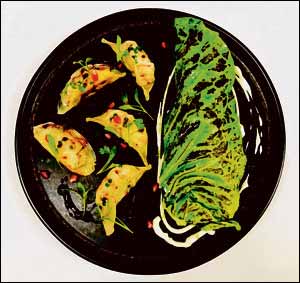| FOOD | |
| Waste not, want not at Succot | |
Dining al fresco is not a new concept. It conjures up memories of sitting somewhere in the Mediterranean, fresh food, views of the sea and weather warm enough for me to get my pasty arms and legs out.
It’s a slightly less romantic scene as you sit in your succah, wrapped up in a blanket with the view of rainy days. So, although we can’t control the weather, we can still celebrate what the harvest has to offer. Like most Jewish festivals, food plays a major part but unlike other festivals Succot is actually about the food and the harvest of it. My cooking philosophy is summed up at Succot. Use ingredients that are in season, available and waste nothing. Here is my take on some traditional Succot dishes.
Etrog marmalade INGREDIENTS
METHOD Put seeds in muslin and tie with string to seal. This may seem a little odd but the seeds contain natural pectin that will help the marmalade set. Put all ingredients in a pan apart from sugar and simmer for 15 minutes. Add sugar and simmer for about an hour. Rake out muslin cloth parcel and discard Take off heat and spoon a little onto a plate and allow to cool. If it is not thick enough for your liking you can put the pan back on and reduce a little more. Just remember it will set as it cools though. Keep in sterilised jars.
Kreplach Gyoza with burnt cabbage, tahini & pomegranate INGREDIENTS
METHOD Pour 2 tbsp vegetable oil into a frying pan on high heat, add chopped onion and garlic until golden and soft. Add mince and fry until brown breaking up with a wooden spoon. (If meat starts to boil as pan is too cold, pour contents into a colander, put pan back on a high heat and add meat back in). Stir in tomato puree, pine nuts and season quite heavily with salt and pepper. Place meat mix on a tray to cool down. Lay out gyoza skins (five at a time), add a teaspoon of mix into the middle, brush the outside with water and pick the whole thing up using both hands. Pinch 1 cm on the left side to seal and then overlap with the next cm to start forming pleats. You can just forget the pleats and fold in half to form a semi-circle. The most important thing however you form your gyoza is to make sure that all the air is removed otherwise they will burst when cooking. Keep on a lightly cornfloured baking sheet until needed. Remove the 4 outer leaves of the hispi cabbage. Remove the spine keeping the leaves intact. Put a frying pan on high heat, add 1 tbsp vegetable oil until smoking and fry one side of the hispi leaves until dark brown and starting to go burnt. Remove and leave until later. Shred the rest of the hispi cabbage Pour 1 tbsp vegetable oil into a frying pan on high heat, add sliced onion until caramelised and add shredded cabbage and caraway seeds. Once soft, squeeze in lemon juice, sugar and salt. Once liquid has evaporated, spoon cabbage mix into burnt leaves and keep warm in oven until needed. Meanwhile, make the tahini dressing. Put tahini paste in a bowl and gradually whisk in warm water until you have a thick dressing consistency, season with salt. Pour 1 tbsp of vegetable oil in a hot pan. Place in gyoza. Once the bottom is golden brown add 2 tbsp of water and quickly place on lid to steam. Arrange 5 gyoza per person on a plate, then place on stuffed cabbage leaf. Drizzle the cabbage with tahini dressing. Drizzle the gyoza with pomegranate molasses and sprinkle over pomegranate seeds. This dish is what we call a ‘Potchke’, but it is well worth the fuss. Serves four.
Autumn fruit compote INGREDIENTS
METHOD Set oven to 180C. Mix all ingredients together in a bowl and then place in a large oven proof dish. Cover with tin foil and bake for 30 minutes. Uncover and baste and put back into the oven for 20 minutes. Serve warm or cold for breakfast or with some ice cream for a great dessert. Serves 10.
|
